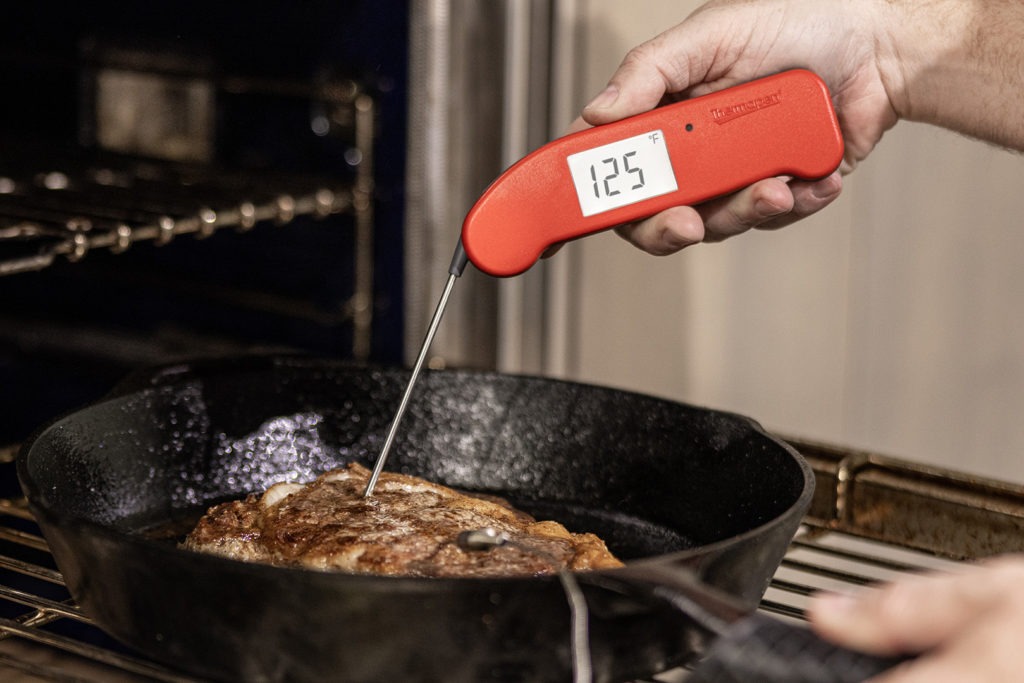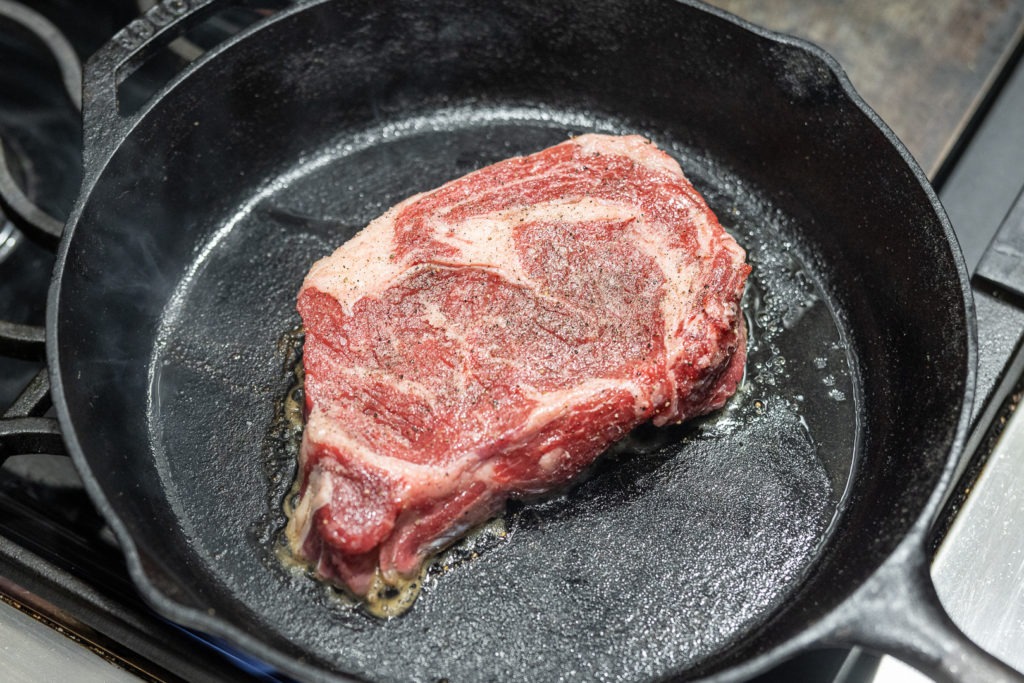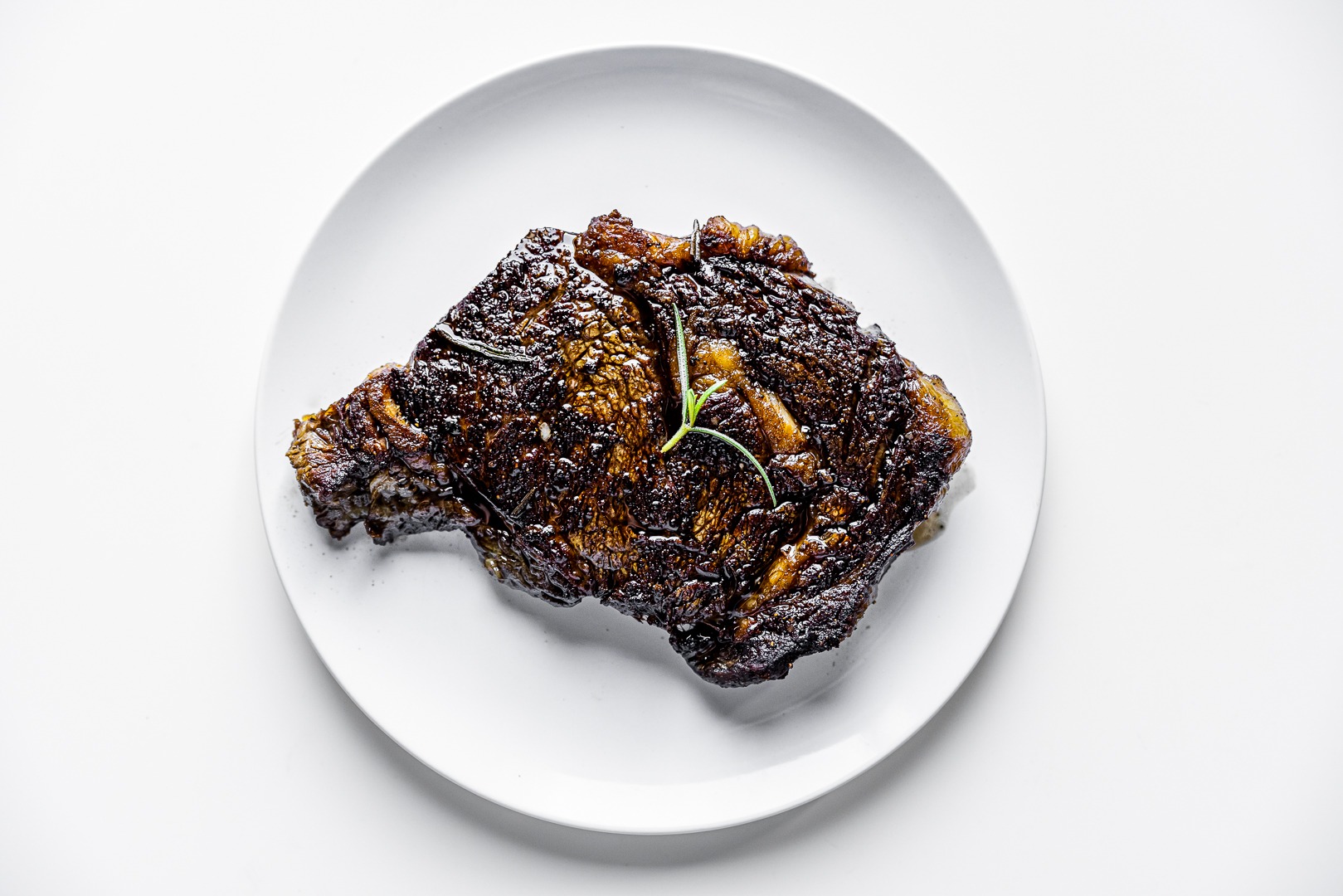How to Sear a Steak
When cooking steak, the sear is of utmost importance. Steak gets most of its deliciousness from Maillard browning, but trying to get a perfect, crisp brown sear can be risky: it’s easy to overcook the center of your steak while you’re striving for exterior perfection.
Here, we’ll give you all the info you need to sear a steak without overcooking. We’ll talk about temperatures and doneness as well as a basic method—one that is used in many quality restaurants—for searing steak. Soon you’ll be searing steaks like a pro for any meal, be it Valentine’s, an anniversary, or just because you want a steak for yourself. Let’s jump in.

Steak checklist: what we want when we want a steak
When we want steak, we want a certain thing, and anything less is…well, less. So what are we looking for? These items pretty much sum it up, I think.
- A quality steak has good beef, beef that can stand up on its own. Now there’s nothing wrong with liking steak sauce, but if your steak needs steak sauce, then it’s probably poorly cooked. A good steak should be able to stand on its own with just salt and pepper. (Need more info on how to pick a steak? Read our Steak Guide!)
- A good steak is well seasoned. It might not need more than salt and peper, but it needs enough salt and pepper. A steak can take more salt than people think, and the only limit for pepper is how much will stick! (If you doubt that, then try making steak au poivre some time. You’ll come around quickly enough!) It is possible to oversalt, but it’s difficult. Season bravely.
- Good steak has plenty of browning. Most of the delicious flavor in a steak comes from Maillard browning, and that browning can only happen when the surface of the steak is dried out. Start with a wet steak and it will take a long time to brown! Pat the surface of your steak with paper towels before cooking to ensure that it browns. Also, make sure you’re cooking it in a hot pan! Nothing browns and crisps at 250°F (121°C). You need a pan that is at least 375°F (191°C) to get the kind of browning you’ll want. (Even hotter is better!)
- A good steak is properly cooked. You can have the greatest piece of meat in the shop, seasoned perfectly, with plenty of browning on the surface, but if it’s overcooked and dry, it’s not a great steak. Temperature monitoring is absolutely essential for a great steak!
Always cook a chilled steak!
Some people say to let a steak warm on the counter before cooking, but that’s wrong. If anything, you should chill your steak further before cooking. If your steak starts at a temperature that is closer to done, it will take less heat to overcook it. By cooking it right out of the fridge, or—even better—placing it in the freezer for a few minutes right before cooking, you create a thermal barrier on the outside of the meat.
When the meat is searing, the heat will have more work to do to overcook the inside of the steak. You’ll have more time for browning, and therefore a deeper sear. You can even temp the steak before cooking. I don’t like to ever cook a steak that is above about 40°F (4°C) internal temp. Use an accurate thermometer like Thermapen® ONE to take your steak’s temp before you cook. A lower internal temperature will be more likely to lead to success!
How to sear a steak the right way
To sear a steak perfectly, start (after chilling it) by patting it dry, then seasoning it with salt. Let the salt soak in while you preheat your oven to 350°F (177°C). If, by the time the oven is preheated, the salt has brought any water to the surface of the meat, pat that off with a paper towel as well. (Keep it in the fridge or freezer during this step, see above.)
Heat a cast-iron or black steel pan over medium-high heat for 5–6 minutes. Right before you cook, season the steak with pepper and put a small amount of oil in the pan. Place your steak in the pan and let it cook for three minutes on one side. It should sizzle well! Flip your steak over and cook for another three minutes.

Finally, flip the steak again and insert a 2.5″ needle probe into the center of the steak. Connect the probe to a ChefAlarm® and set the high-temp alarm for 10°F (6°C) below your desired doneness temp. Put the steak, still in the cast-iron pan, in the oven. Let the steak cook in the oven until the high-temp alarm sounds on your ChefAlarm. Verify the temperature with your Thermapen ONE (you may have had the tip of the probe in a hotter part of the steak than it should be). If you don’t see a temp lower than your set temp, remove the steak from the oven and transfer it to a plate to rest.
Tent the steak loosely with foil as it rests for five minutes. During this time, the temperatures in the steak will equalize and the steak’s internal temperature will rise by about 10°F (6°C). After the steak rests, it’s time to eat!
Note: Some people even pat the juices off of the surface of their steak after the rest and toss it back in a very hot pan to re-awaken the sear. If you plan on doing that, move all your temperatures back another 5°F (3°C). Use thermal thinking and you can find your perfect way to sear a steak.
What temp is my steak done at?
It is generally agreed upon that steaks are best cooked to medium-rare or, at the most, medium. That is not to say you can’t like your steak more (or less) done—you do you! But no matter how you like your steak, you should make sure you cook it to exactly that temperature. Medium rare steak is done at 130–135°F (54–57°C), medium-cooked steak is done at 135–145°F (57–63°C). Medium-well starts where medium leaves off, of course.
Other searing options
The process we’ve described here is sometimes referred to as a “forward sear,” and it is nearly foolproof. Use that temperature probe when you put the steak in the oven, pull it 10°F (6°C) lower than your desired doneness, and you’re almost guaranteed to hit your mark.
There are, though, other ways to sear a steak. As the name “forward sear” implies, there is also a “reverse sear.” In a reverse sear, the steak is cooked slowly in gentle heat, then seared quickly to finish it. If you want to give the reverse sear a shot, take a look at this post on reverse-searing on the grill, or give this video a look:
The most extreme, precise form of reverse searing involves a sous vide circulator, and we also have instructions for that.
No matter how you end up searing your steak, be it forward or reverse searing, make sure you keep an eye on its temperature. Choose a good cut of meat, season it well, sear it for a delicious crust, and don’t overcook it. Do that and you’ll have the best steaks right from your own kitchen.



Looking forward to winning a new thermapen one
Hope you won! That would so awesome!
I think you screwed up temperature, 10 F isn’t anywhere right!
The steaks I cooked by this method rose by about 10°F in the rest. But if yours are rising by more, then definitely remove them from heat sooner!
I think you screwed up reading…it says 10℉ less than your desired doneness.
“10F less than desired doneness”. I had the same reaction until I read it again.
So if I’m reading this right. Steaks are done when they are frozen? 10f is either a mistake or your into meatcicles.
10°F lower than desire doneness temperature, sorry.